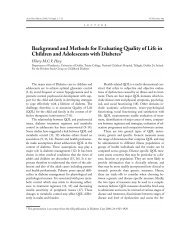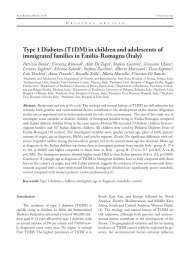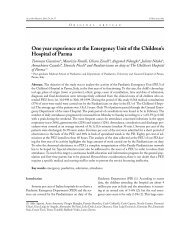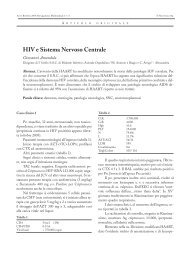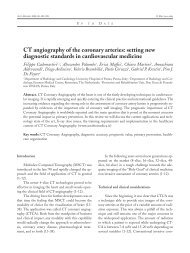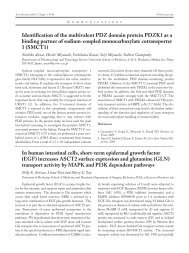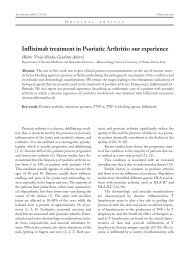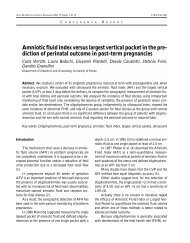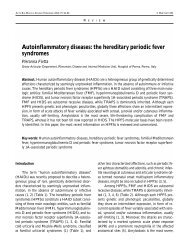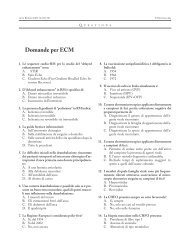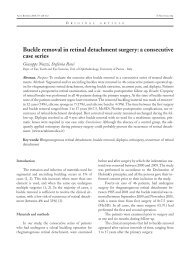Contribution of studies on renal effects of heavy metals and selected ...
Contribution of studies on renal effects of heavy metals and selected ...
Contribution of studies on renal effects of heavy metals and selected ...
Create successful ePaper yourself
Turn your PDF publications into a flip-book with our unique Google optimized e-Paper software.
Toxic nephropathies from industrial chemicals<br />
59<br />
The epidemiological approach to the nephrotoxicity<br />
Epidemiology <str<strong>on</strong>g>of</str<strong>on</strong>g> nephrotoxicity by individual<br />
chemicals or mixed exposures has been inadequately<br />
studied. The c<strong>on</strong>tributi<strong>on</strong> <str<strong>on</strong>g>of</str<strong>on</strong>g> chemicals to the overall<br />
incidence <str<strong>on</strong>g>of</str<strong>on</strong>g> nephropathy <strong>and</strong> <str<strong>on</strong>g>of</str<strong>on</strong>g> chr<strong>on</strong>ic <strong>renal</strong> failure<br />
is, with few excepti<strong>on</strong>s, undefined. In the case <str<strong>on</strong>g>of</str<strong>on</strong>g> some<br />
occupati<strong>on</strong>ally exposed groups <strong>and</strong> analgesic-associated<br />
<strong>renal</strong> disease, there has been extensive research that<br />
has shown variati<strong>on</strong>s in incidence between groups <strong>and</strong><br />
countries. It was finally estimated that up to 5% <str<strong>on</strong>g>of</str<strong>on</strong>g><br />
end-stage <strong>renal</strong> disease may be due to toxic<br />
nephropathies <strong>and</strong> about 50% <str<strong>on</strong>g>of</str<strong>on</strong>g> end-stage <strong>renal</strong> disease<br />
is <str<strong>on</strong>g>of</str<strong>on</strong>g> unknown etiology (1).<br />
A major problem in assigning a cause to endstage<br />
<strong>renal</strong> disease is the l<strong>on</strong>g latency <strong>and</strong> subsequent<br />
slow development <str<strong>on</strong>g>of</str<strong>on</strong>g> chr<strong>on</strong>ic <strong>renal</strong> failure, which<br />
makes retrospective identificati<strong>on</strong> <str<strong>on</strong>g>of</str<strong>on</strong>g> the causative<br />
agent difficult. More importantly, the etiology may be<br />
obscured by lack <str<strong>on</strong>g>of</str<strong>on</strong>g> reliable informati<strong>on</strong> <strong>on</strong> the likely<br />
causative agents, the levels <strong>and</strong> durati<strong>on</strong> <str<strong>on</strong>g>of</str<strong>on</strong>g> exposure,<br />
<strong>and</strong> other possible c<strong>on</strong>tributing <strong>and</strong> exacerbating factors<br />
(2).<br />
The health significance <str<strong>on</strong>g>of</str<strong>on</strong>g> nephrotoxicity is also<br />
difficult to assess because <str<strong>on</strong>g>of</str<strong>on</strong>g> the diverse array <str<strong>on</strong>g>of</str<strong>on</strong>g> chemicals<br />
that target different parts <str<strong>on</strong>g>of</str<strong>on</strong>g> the kidney, the spectrum<br />
<str<strong>on</strong>g>of</str<strong>on</strong>g> disease c<strong>on</strong>sequences, <strong>and</strong> several interacting<br />
factors. Many industrial <strong>and</strong> envir<strong>on</strong>mental chemicals<br />
have been shown in experimental <str<strong>on</strong>g>studies</str<strong>on</strong>g> to be<br />
nephrotoxic, but the extent <str<strong>on</strong>g>of</str<strong>on</strong>g> their c<strong>on</strong>tributi<strong>on</strong> to the<br />
overall incidence <str<strong>on</strong>g>of</str<strong>on</strong>g> chr<strong>on</strong>ic <strong>renal</strong> failure is not known.<br />
However, nearly 50% <str<strong>on</strong>g>of</str<strong>on</strong>g> these patients were c<strong>on</strong>sidered<br />
possible (but not diagnosed) cases <str<strong>on</strong>g>of</str<strong>on</strong>g> toxic<br />
nephropathy (3, 4). Of those patients identified as<br />
having chemical-related <strong>renal</strong> disease, analgesic<br />
nephropathy is the most important recognized outcome,<br />
the prevalence varying greatly between countries,<br />
whereas some patients had other specific drug or<br />
chemical-related nephropathies (3).<br />
The major occupati<strong>on</strong>al exposure is to workplace<br />
solvents, but other organic compounds, including pesticides,<br />
<strong>and</strong> toxic <strong>metals</strong> are <str<strong>on</strong>g>of</str<strong>on</strong>g> great c<strong>on</strong>cern. The well<br />
documented occurrence <str<strong>on</strong>g>of</str<strong>on</strong>g> nephropathies in subjects<br />
occupati<strong>on</strong>ally exposed to lead or cadmium, the excess<br />
<str<strong>on</strong>g>of</str<strong>on</strong>g> mortality for <strong>renal</strong> diseases in cohorts <str<strong>on</strong>g>of</str<strong>on</strong>g> workers<br />
with previous exposure to these two <strong>heavy</strong> <strong>metals</strong> (5),<br />
<strong>and</strong> evidence that subclinical <strong>renal</strong> <strong>effects</strong> caused by<br />
cadmium are early signs <str<strong>on</strong>g>of</str<strong>on</strong>g> an accelerated <strong>and</strong> irreversible<br />
decline <str<strong>on</strong>g>of</str<strong>on</strong>g> <strong>renal</strong> functi<strong>on</strong> (6) point to the importance<br />
<str<strong>on</strong>g>of</str<strong>on</strong>g> occupati<strong>on</strong>al exposure to nephrotoxic<br />
agents as causal agents or modifying factors c<strong>on</strong>tributing<br />
to the burden <str<strong>on</strong>g>of</str<strong>on</strong>g> end-stage <strong>renal</strong> disease.<br />
Significantly increased risks <str<strong>on</strong>g>of</str<strong>on</strong>g> chr<strong>on</strong>ic <strong>renal</strong> failure<br />
(CRF) were found for exposure to lead [odds ratio<br />
2.11 (95% CI 1.23-4.36)], copper [2.54 (1.16-5.53)],<br />
chromium [2.77 (1.21-6.33)], tin [3.72 (1.22-11.3)],<br />
mercury [5.13 (1.02-25.7)], welding fumes [2.06<br />
(1.05-4.04)], <strong>and</strong> oxygenated hydrocarb<strong>on</strong>s [5.45<br />
(1.84-16.2)] (7). However, the low incidence <str<strong>on</strong>g>of</str<strong>on</strong>g><br />
chr<strong>on</strong>ic nephropathies raises methodological issues in<br />
carrying <strong>and</strong> interpreting epidemiological <str<strong>on</strong>g>studies</str<strong>on</strong>g><br />
aimed to the identificati<strong>on</strong> <str<strong>on</strong>g>of</str<strong>on</strong>g> aetiological agents acting<br />
as pathogenetic factors, as well as <str<strong>on</strong>g>of</str<strong>on</strong>g> those risk factors<br />
which, interacting with occupati<strong>on</strong>al exposure,<br />
can modulate the progressi<strong>on</strong> <str<strong>on</strong>g>of</str<strong>on</strong>g> early changes towards<br />
overt <strong>renal</strong> dysfuncti<strong>on</strong> leading to end-stage <strong>renal</strong><br />
disease (8). For instance, the frequencies <str<strong>on</strong>g>of</str<strong>on</strong>g> various<br />
occupati<strong>on</strong>al exposures were high am<strong>on</strong>g patients<br />
with diabetic nephropathy (7).<br />
To overcome such limitati<strong>on</strong>s <str<strong>on</strong>g>of</str<strong>on</strong>g> epidemiological<br />
<str<strong>on</strong>g>studies</str<strong>on</strong>g>, two main approaches have been explored: (i)<br />
human <str<strong>on</strong>g>studies</str<strong>on</strong>g> relying <strong>on</strong> biomarkers <str<strong>on</strong>g>of</str<strong>on</strong>g> early <strong>renal</strong><br />
effect <strong>and</strong> (ii) experimental models <str<strong>on</strong>g>of</str<strong>on</strong>g> nephrotoxicity.<br />
Biomarkers are expected to increase the sensitivity <str<strong>on</strong>g>of</str<strong>on</strong>g><br />
traditi<strong>on</strong>al approaches based <strong>on</strong> crude measures <str<strong>on</strong>g>of</str<strong>on</strong>g> exposure<br />
(e.g., job titles) <strong>and</strong> <str<strong>on</strong>g>of</str<strong>on</strong>g> outcome (e.g., death<br />
certificates); for use in preventive medicine, biomarkers<br />
should not be regarded as diagnostic tests but<br />
rather as indicators that early, reversible changes have<br />
occurred that could later lead to clinical disease (2, 8).<br />
Experimental models have been aimed not <strong>on</strong>ly at<br />
evaluating morphological alterati<strong>on</strong>s or pathology,<br />
but also at investigating the biochemical <strong>and</strong> functi<strong>on</strong>al<br />
correlates <str<strong>on</strong>g>of</str<strong>on</strong>g> such changes (1). The originality<br />
<str<strong>on</strong>g>of</str<strong>on</strong>g> the approach used in occupati<strong>on</strong>al toxicology has<br />
been the integrati<strong>on</strong> between findings gathered from<br />
epidemiological investigati<strong>on</strong>s <strong>on</strong> groups at risk, the<br />
validati<strong>on</strong> <str<strong>on</strong>g>of</str<strong>on</strong>g> sensitive biomarkers in the same groups,<br />
<strong>and</strong> the applicati<strong>on</strong> <str<strong>on</strong>g>of</str<strong>on</strong>g> the same effect biomarkers<br />
used to m<strong>on</strong>itor workers occupati<strong>on</strong>ally exposed to<br />
nephrotoxic chemicals in <strong>selected</strong> animal models (1,<br />
2, 8, 9).



